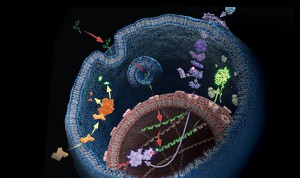
Search the PubMed database for “dual-luciferase” and citations abound. The Dual-Luciferase® Reporter Assay is a powerful tool that allows researchers to ask a multitude of questions about gene control and expression in a system that itself could be normalized and internally controlled. For more than 15 years, firefly and Renilla luciferases have formed the basis of a range of powerful assays and research tools for scientists who are asking questions about the deep and complex genetic and cellular story associated with cancer. Here we talk a bit of about bioluminescent chemistries, some of the newest bioluminescent tools available, and how some of these tools can be used to probe the deeper questions of cell biology, including cancer biology.
Why luminescence?
Both luminescence and fluorescence are important technologies in scientific research, but because of differences in the physical processes of excitation, each one is best suited to different tasks. Fluorescent compounds tend to be very bright, and this high signal makes them particularly well suited for activities where the signal is going to be small: fluorescence microscopy from single cells, for instance, or fluorescence-activated cell sorting (FACS). However all of that extremely bright signal comes at a price: higher background. Fluorescent compounds tend also to be subject to interference from compounds found in compound libraries and in many common laboratory solutions.
Luminescence, on the other hand, is suitable for larger samples, like cells plated in a multiwell plate or in vivo imaging in mice. Luminescence has low background, and there is little compound interference associated with luminescence, making the signal-to-background ratio quite high, conferring a naturally high level of sensitivity to the technology for screening and other activities.
Engineering a Brighter, More Sensitive Future: The luc2 gene and NanoLuc® Luciferases
Since the first luminescent tools were introduced, researchers have been working to improve them so that they are more effective probes for biological processes. Firefly luciferase, the work horse of the luciferase reporter gene assay, continues to be improved with the newest generation of firefly luciferase vectors, the pGL4 Vectors. With the pGL3 backbone as a starting point, 75% of the consensus transcription factor binding sites were removed to greatly reduce the risk of anomalous expression. Other modifications were also made to the vector. In addition to vector backbone modifications, the luciferase gene itself was also engineered to remove cryptic regulatory sequences and optimize codon basis for expression in mammalian cells, leading to the creation of the luc2 gene. A full range of pGL4 Vectors now exists to allow this improved luciferase to be used in a variety of experimental designs from reporter gene assays to cell signaling experiments.
NanoLuc® Luciferase is the newest tool in the arsenal of luminescent chemistries. Derived from the deep sea shrimp, Oplophorus gracilirostris, the bright blue luminescence is the result of the activity of a small 19kDa catalytic luciferase subunit. Researchers at Promega used bioinformatics, directed evolution and organic chemistry to produce an engineered luciferase and substrate that produce an extremely bright signal. Equimolar amounts of NanoLuc® luciferase and its substrate are approximately 100-fold brighter than either Renilla or firefly luciferases. Because of its small size, NanoLuc® lends itself to uses beyond reporter assays, and serves as a good fusion partner for protein studies. Initial work has demonstrated that NanoLuc® luciferase can be localized to the mitocondria, ER, nucleus and plasma membrane of mammalian cells. This luciferase has potential uses in protein translocation, protein stability, receptor interaction, protein:protein interaction and biosensor experiments.

Things You Can Do with Bioluminescence that Don’t Involve Reporter Genes
The luciferase/luciferin reaction requires four key components: oxygen, luciferase, luciferin and ATP. Any one of these is limiting and depending upon which one you limit you can measure different things. Reporter gene assays make the luciferase the limiting factor. Limiting either of the other two gives you the ability to create biochemical and cell-based assays for a variety of target molecules. All of these assays come with the same advantages of any bioluminescent assay: high senstivity, low background, little interference.
For instance, ATP is a hallmark of viable cells, and you need ATP for the luciferase/luciferin reaction. The CellTiter-Glo® Viability 2.0 Assay takes advantage of this relationship to produce a highly reliable assay for cell viability that is amenable to high-throughput settings, and the CellTiter-Glo® 3D Assay and has been designed specifically to work with 3D cell culture models.
Looking at ATP as the limiting reagent and the relationship between ADP and ATP allows you to take advantage of the luciferase reaction to create a universal assay for virtually any kinase/kinase substrate combination, such as the ADP-Glo™ Assay.
Or if you have some clever chemists around you can design enzyme substrates so that when the enzyme cleaves or modifies the substrate, luciferin is produced allowing a luciferase reaction to proceed. Assays such as the Caspase-Glo® Assays or the P450-Glo™ Assays use this strategy.
The nice thing about all of these assays is that many of them can be multiplexed with other chemistries, including fluorescent ones, so that you can get data for multiple parameters from a single sample.
Related Posts
Michele Arduengo
Latest posts by Michele Arduengo (see all)
- An Unexpected Role for RNA Methylation in Mitosis Leads to New Understanding of Neurodevelopmental Disorders - March 27, 2025
- Unlocking the Secrets of ADP-Ribosylation with Arg-C Ultra Protease, a Key Enzyme for Studying Ester-Linked Protein Modifications - November 13, 2024
- Exploring the Respiratory Virus Landscape: Pre-Pandemic Data and Pandemic Preparedness - October 29, 2024
